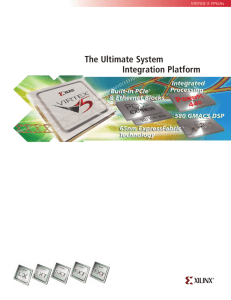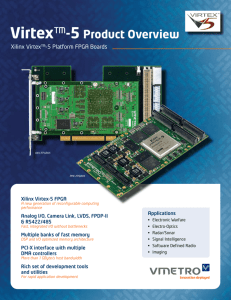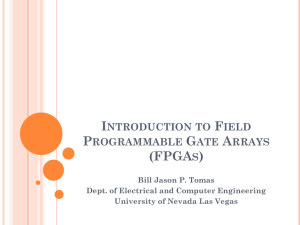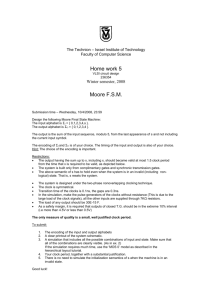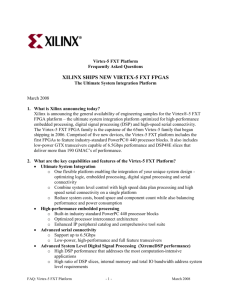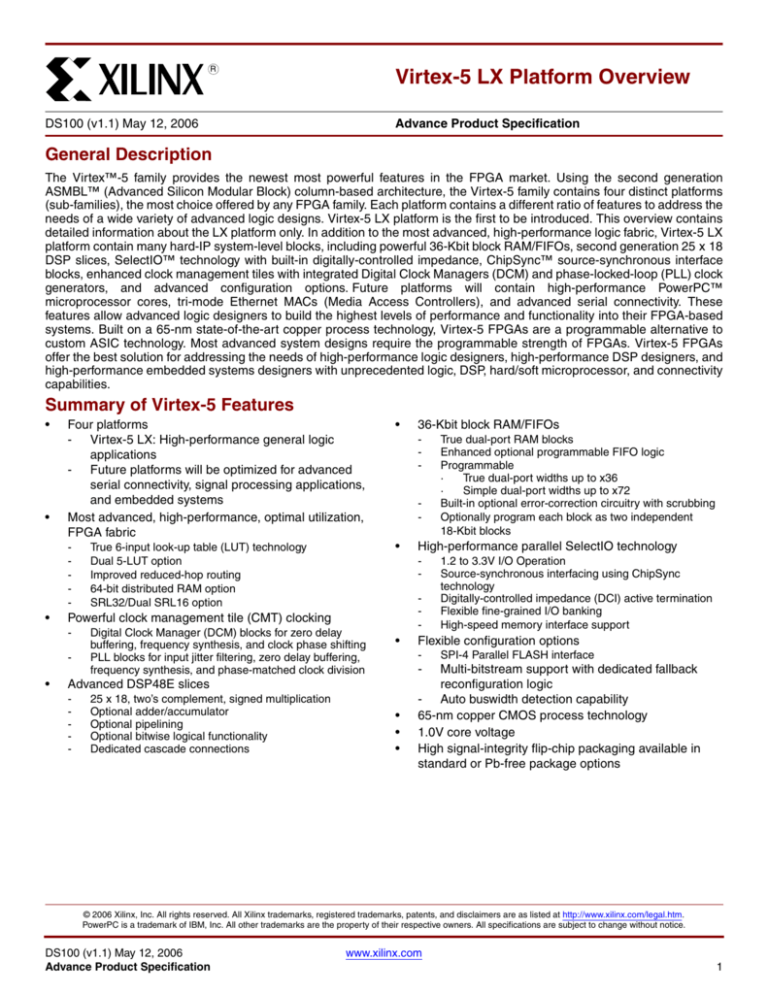
0
R
DS100 (v1.1) May 12, 2006
Virtex-5 LX Platform Overview
0
0
Advance Product Specification
General Description
The Virtex™-5 family provides the newest most powerful features in the FPGA market. Using the second generation
ASMBL™ (Advanced Silicon Modular Block) column-based architecture, the Virtex-5 family contains four distinct platforms
(sub-families), the most choice offered by any FPGA family. Each platform contains a different ratio of features to address the
needs of a wide variety of advanced logic designs. Virtex-5 LX platform is the first to be introduced. This overview contains
detailed information about the LX platform only. In addition to the most advanced, high-performance logic fabric, Virtex-5 LX
platform contain many hard-IP system-level blocks, including powerful 36-Kbit block RAM/FIFOs, second generation 25 x 18
DSP slices, SelectIO™ technology with built-in digitally-controlled impedance, ChipSync™ source-synchronous interface
blocks, enhanced clock management tiles with integrated Digital Clock Managers (DCM) and phase-locked-loop (PLL) clock
generators, and advanced configuration options. Future platforms will contain high-performance PowerPC™
microprocessor cores, tri-mode Ethernet MACs (Media Access Controllers), and advanced serial connectivity. These
features allow advanced logic designers to build the highest levels of performance and functionality into their FPGA-based
systems. Built on a 65-nm state-of-the-art copper process technology, Virtex-5 FPGAs are a programmable alternative to
custom ASIC technology. Most advanced system designs require the programmable strength of FPGAs. Virtex-5 FPGAs
offer the best solution for addressing the needs of high-performance logic designers, high-performance DSP designers, and
high-performance embedded systems designers with unprecedented logic, DSP, hard/soft microprocessor, and connectivity
capabilities.
Summary of Virtex-5 Features
•
•
•
Four platforms
- Virtex-5 LX: High-performance general logic
applications
- Future platforms will be optimized for advanced
serial connectivity, signal processing applications,
and embedded systems
Most advanced, high-performance, optimal utilization,
FPGA fabric
•
-
•
-
-
Digital Clock Manager (DCM) blocks for zero delay
buffering, frequency synthesis, and clock phase shifting
PLL blocks for input jitter filtering, zero delay buffering,
frequency synthesis, and phase-matched clock division
-
•
25 x 18, two’s complement, signed multiplication
Optional adder/accumulator
Optional pipelining
Optional bitwise logical functionality
Dedicated cascade connections
1.2 to 3.3V I/O Operation
Source-synchronous interfacing using ChipSync
technology
Digitally-controlled impedance (DCI) active termination
Flexible fine-grained I/O banking
High-speed memory interface support
Flexible configuration options
-
SPI-4 Parallel FLASH interface
-
Advanced DSP48E slices
-
True dual-port RAM blocks
Enhanced optional programmable FIFO logic
Programmable
·
True dual-port widths up to x36
·
Simple dual-port widths up to x72
Built-in optional error-correction circuitry with scrubbing
Optionally program each block as two independent
18-Kbit blocks
High-performance parallel SelectIO technology
-
Powerful clock management tile (CMT) clocking
-
•
True 6-input look-up table (LUT) technology
Dual 5-LUT option
Improved reduced-hop routing
64-bit distributed RAM option
SRL32/Dual SRL16 option
36-Kbit block RAM/FIFOs
•
•
•
Multi-bitstream support with dedicated fallback
reconfiguration logic
- Auto buswidth detection capability
65-nm copper CMOS process technology
1.0V core voltage
High signal-integrity flip-chip packaging available in
standard or Pb-free package options
© 2006 Xilinx, Inc. All rights reserved. All Xilinx trademarks, registered trademarks, patents, and disclaimers are as listed at http://www.xilinx.com/legal.htm.
PowerPC is a trademark of IBM, Inc. All other trademarks are the property of their respective owners. All specifications are subject to change without notice.
DS100 (v1.1) May 12, 2006
Advance Product Specification
www.xilinx.com
1
R
Virtex-5 LX Platform Overview
Table 1: Virtex-5 LX FPGA Family Members
Configurable Logic Blocks (CLBs)
Device
Array
(Row x Col)
Virtex-5
Slices(1)
Max
Distributed RAM (Kb)
XC5VLX30
80 x 30
4,800
320
XC5VLX50
120 x 30
7,200
XC5VLX85
120 x 54
XC5VLX110
Block RAM Blocks
DSP48E Slices(2)
CMTs(4) Total I/O Banks
Max User I/O
18 Kb(3)
36 Kb
Max (Kb)
32
64
32
1,152
2
13
400
480
48
96
48
1,728
6
17
560
12,960
840
48
192
96
3,456
6
17
560
160 x 54
17,280
1,120
64
256
128
4,608
6
23
800
XC5VLX220
160 x 108
34,560
2,280
128
384
192
6,912
6
23
800
XC5VLX330
240 x 108
51,840
3,420
192
576
288
10,368
6
35
1,200
Notes:
1.
Virtex-5 slices are organized differently from previous generations. Each Virtex-5 slice contains four LUTs and four flip-flops (previously it was two LUTs and two flip-flops.)
2.
Each DSP48E slice contains a 25 x 18 multiplier, an adder, and an accumulator.
3.
Virtex-5 block RAMs are fundamentally 36 Kbits in size. Each block can also be used as two independent 18-Kbit blocks.
4.
Each Clock Management Tile (CMT) contains two DCMs and one PLL.
Virtex-5 Logic Fabric
550 MHz Clock Technology
•
•
•
•
•
•
Up to 50% speed improvement
On average, one to two speed grade improvement over
Virtex-4 devices
Cascadable 32-bit variable shift registers or 64-bit
distributed memory capability
Superior routing architecture with enhanced diagonal
routing supports block-to-block connectivity with
minimal hops
Up to 330,000 logic cells including:
- Up to 207,360 internal fabric flip-flops with clock
enable (XC5VLX330)
- Up to 207,360 true 6-input look-up tables (LUTs)
with greater than 13 million total LUT bits
- Two outputs for dual 5-LUT mode gives enhanced
utilization
- Logic expanding multiplexers and I/O registers
•
•
•
DS100 (v1.1) May 12, 2006
Advance Product Specification
Up to six Clock Management Tiles (CMTs)
- Each CMT contains two DCMs and one
PLL/PMCD — up to eighteen total clock generators
- Flexible DCM-to-PLL or PLL-to-DCM cascade
- Precision clock deskew and phase shift
- Flexible frequency synthesis
- Multiple operating modes to ease performance
trade-off decisions
- Improved maximum input/output frequency
- Fine-grained phase shifting resolution
- Input jitter filtering
- Low-power operation
- Wide phase shift range
- Phase-Matched Clock Divider (PMCD) functionality
Differential clock tree structure for optimized low-jitter
clocking and precise duty cycle
32 global clock networks
Regional, I/O, and local clocks in addition to global
clocks
www.xilinx.com
2
R
Virtex-5 LX Platform Overview
550 MHz Integrated Block Memory
•
•
•
•
•
•
•
•
•
•
•
Up to 10.3 Mbits of integrated block memory in the LX
platform
36-Kbit blocks with optional dual 18-Kbit mode
True dual-port RAM cells
Independent port width selection (x1 to x72)
- Up to x36 total per port for true dual port operation
- Up to x72 total per port for simple dual port
operation (one Read port and one Write port)
- Memory bits plus parity/sideband memory support
for x9, x18, x36, and x72 widths
- Configurations from 32K x 1 to 512 x 72
(8K x 4 to 512 x 72 for FIFO operation)
Multirate FIFO support logic
- Full and Empty flag with fully programmable Almost
Full and Almost Empty flags
Synchronous FIFO support without Flag uncertainty
Optional pipeline stages for higher performance
Byte-write capability
Dedicated cascade routing to form 64K x 1 memory
without using FPGA routing
Integrated optional ECC for high-reliability memory
requirements
- Optional ECC scrubbing support
Special reduced-power design for 18 Kbit and below
operation
550 MHz DSP48E Slices
•
•
•
•
•
•
•
•
•
•
Up to 1,200 user I/Os
Wide selection of I/O standards from 1.2V to 3.3V
Extremely high-performance
- Up to 800 Mb/s HSTL and SSTL
(on all single-ended I/Os)
- Up to 1.25 Gb/s LVDS (on all differential I/O pairs)
True differential termination on-chip
Same edge capture at input and output I/Os
Extensive memory interface support
DS100 (v1.1) May 12, 2006
Advance Product Specification
•
•
•
•
•
Works in conjunction with SelectIO technology to
simplify source-synchronous interfaces
Per-bit deskew capability built into all I/O blocks
(variable delay line on all inputs and outputs)
Dedicated I/O and regional clocking resources (pins
and trees)
Built-in data serializer/deserializer logic with
corresponding clock divider support in all I/O
Networking/telecommunication interfaces up to
1.25 Gb/s
Digitally Controlled Impedance (DCI)
Active I/O Termination
•
•
•
Optional series or parallel termination
Temperature and voltage compensation
Makes board layout much easier
- Reduces resistors
- Places termination in the ideal location, at the
signal source or destination
Configuration
•
•
•
Dedicated 25-bit x 18-bit multiplier
Optional pipeline stages for enhanced performance
Optional 48-bit accumulator for multiply accumulate
(MACC) operation with optional accumulator cascade
to 96-bits
Integrated adder for complex-multiply or multiply-add
operation
Optional bitwise logical operation modes
Independent C registers per slice
Fully cascadable in a DSP column without external
routing resources
SelectIO Technology
•
•
•
ChipSync Source-Synchronous
Interfacing Logic
•
•
•
Support for Platform Flash, standard SPI Flash, or
standard parallel NOR Flash configuration
Bitstream support with dedicated fallback
reconfiguration logic
256-bit AES bitstream decryption provides intellectual
property security and prevents design copying
Improved bitstream error detection/correction capability
Auto Buswidth detection capability
Partial Reconfiguration via ICAP port
65-nm Copper CMOS Process
•
•
•
1.0V Core Voltage
12-layer metal provides maximum routing capability
and accommodates hard-IP immersion
Triple-oxide technology for proven reduced static power
consumption
Advanced Flip-Chip Packaging
•
•
•
Pre-engineered packaging technology for proven
superior signal integrity
- Minimized inductive loops from signal to return
- Optimal signal-to-PWR/GND ratios
Reduces SSO induced noise by up to 7x
Pb-Free and standard packages
www.xilinx.com
3
R
Virtex-5 LX Platform Overview
Architectural Description
Virtex-5 Array Overview
Virtex-5 devices are user-programmable gate arrays with
various configurable elements and embedded cores optimized for high-density and high-performance system
designs. Virtex-5 devices implement the following functionality:
• I/O blocks provide the interface between package pins
and the internal configurable logic. Most popular and
leading-edge I/O standards are supported by
programmable I/O blocks (IOBs). The IOBs can be
connected to very flexible ChipSync logic for enhanced
source-synchronous interfacing. Source-synchronous
optimizations include per-bit deskew (on both input and
output signals), data serializers/deserializers, clock
dividers, and dedicated I/O and local clocking
resources.
• Configurable Logic Blocks (CLBs), the basic logic
elements for Xilinx FPGAs, provide combinatorial and
synchronous logic as well as distributed memory and
SRL32 shift register capability. Virtex-5 CLBs are
based on true 6-input look-up table technology and
provide superior capabilities and performance
compared to previous generations of programmable
logic.
•
•
•
Block RAM modules provide flexible 36 Kbit true
dual-port RAM that are cascadable to form larger
memory blocks. In addition, Virtex-5 block RAMs
contain optional programmable FIFO logic for
increased device utilization. Each Virtex-5 block RAM
can also be configured as two independent 18 Kbit true
dual-port RAM blocks, providing memory granularity for
designs needing smaller RAM blocks.
Cascadable embedded DSP48E slices with
25-bit x 18-bit dedicated multipliers, integrated adder,
and 48-bit accumulator provide massively parallel DSP
algorithm support. In addition, each DSP48E slice can
be used to perform bitwise logical functions.
Clock Management Tile (CMT) blocks provide the most
flexible, highest-performance clocking for FPGAs. Each
CMT contains two Digital Clock Manager (DCM) blocks
(self-calibrating, fully digital), and one PLL/PMCD block
(self-calibrating, analog) for clock distribution delay
compensation, clock multiplication/division,
coarse-/fine-grained clock phase shifting, and input
clock jitter filtering.
Virtex-5 Features
This section briefly describes the features of the Virtex-5 family of FPGAs.
Input/Output Blocks (SelectIO)
IOBs are programmable and can be categorized as follows:
• Programmable single-ended or differential (LVDS)
operation
• Input block with an optional single data rate (SDR) or
double data rate (DDR) register
• Output block with an optional SDR or DDR register
• Bidirectional block
• Per-bit deskew circuitry
• Dedicated I/O and regional clocking resources
• Built in data serializer/deserializer
The IOB registers are either edge-triggered D-type flip-flops
or level-sensitive latches.
IOBs support the following single-ended standards:
• LVTTL
• LVCMOS (3.3V, 2.5V, 1.8V, 1.5V, and 1.2V)
• PCI (33 and 66 MHz)
• PCI-X
• GTL and GTLP
• HSTL 1.5V and 1.8V (Class I, II, III, and IV)
• HSTL 1.2V (Class 1)
• SSTL 1.8V and 2.5V (Class I and II)
DS100 (v1.1) May 12, 2006
Advance Product Specification
The Digitally Controlled Impedance (DCI) I/O feature can be
configured to provide on-chip termination for each
single-ended I/O standard and some differential I/O standards.
The IOB elements also support the following differential signaling I/O standards:
• LVDS and Extended LVDS (2.5V only)
• BLVDS (Bus LVDS)
• ULVDS
• Hypertransport™
• Differential HSTL 1.5V and 1.8V (Class I and II)
• Differential SSTL 1.5V and 1.8V (Class I and II)
• RSDS (2.5V point-to-point)
Two adjacent pads are used for each differential pair. Two or
four IOB blocks connect to one switch matrix to access the
routing resources.
www.xilinx.com
4
R
Virtex-5 LX Platform Overview
Per-bit deskew circuitry allows for programmable signal
delay internal to the FPGA. Per-bit deskew flexibly provides
fine-grained increments of delay to carefully produce a
range of signal delays. This is especially useful for synchronizing signal edges in source-synchronous interfaces.
General purpose I/O in select locations (eight per bank) are
designed to be “regional clock capable” I/O by adding special hardware connections for I/O in the same locality. These
regional clock inputs are distributed within a limited region
to minimize clock skew between IOBs. Regional I/O clocking supplements the global clocking resources.
Data serializer/deserializer capability is added to every I/O
to support source-synchronous interfaces. A serial-to-parallel converter with associated clock divider is included in the
input path, and a parallel-to-serial converter in the output
path.
An in-depth guide to the Virtex-5 IOB is found in the
Virtex-5 User Guide.
Configurable Logic Blocks (CLBs)
A Virtex-5 CLB resource is made up of two slices. Each
slice is equivalent and contains:
• Four function generators
• Four storage elements
• Arithmetic logic gates
• Large multiplexers
• Fast carry look-ahead chain
The function generators are configurable as 6-input LUTs or
dual-output 5-input LUTs. SLICEMs in some CLBs can be
configured to operate as 32-bit shift registers (or 16-bit x 2
shift registers) or as 64-bit distributed RAM. In addition, the
four storage elements can be configured as either edge-triggered, D-type flip-flops or level sensitive latches. Each CLB
has internal fast interconnect and connects to a switch
matrix to access general routing resources.
The Virtex-5 CLBs are further discussed in the
Virtex-5 User Guide.
Block RAM
The 36 Kbit true dual-port RAM block resources are programmable from 32K x 1 to 512 x 72, in various depth and
width configurations. In addition, each 36-Kbit block can
also be configured to operate as two, independent 18-Kbit
dual-port RAM blocks.
Each port is totally synchronous and independent, offering
three “read-during-write” modes. Block RAM is cascadable
to implement large embedded storage blocks. Additionally,
back-end pipeline registers, clock control circuitry, built-in
FIFO support, ECC, and byte write enable features are also
provided as options.
The block RAM feature in Virtex-5 devices is further discussed in the Virtex-5 User Guide.
DS100 (v1.1) May 12, 2006
Advance Product Specification
DSP48E Slices
DSP48E slice resources contain a dedicated 25 x 18-bit
two’s complement signed multiplier, adder logic, and a
48-bit accumulator. Each multiplier or accumulator can be
used independently. Each DSP48E slice also contains
extensive cascade capability to efficiently implement
high-speed DSP algorithms.
The Virtex-5 DSP48E slice features are further discussed in
Virtex-5 XtremeDSP Design Considerations.
Global Clocking
The CMTs and global-clock multiplexer buffers provide a
complete solution for designing high-speed clock networks.
Each CMT contains two DCMs and one PLL/PMCD. The
DCMs and PLL/PMCDs can be used independently or
extensively cascaded. Up to six CMT blocks are available,
providing up to eighteen total clock generator elements.
Each DCM provides familiar clock generation capability. To
generate deskewed internal or external clocks, each DCM
can be used to eliminate clock distribution delay. The DCM
also provides 90°, 180°, and 270° phase-shifted versions of
the output clocks. Fine-grained phase shifting offers
higher-resolution phase adjustment with fraction of the
clock period increments. Flexible frequency synthesis provides a clock output frequency equal to a fractional or integer multiple of the input clock frequency.
To augment the DCM capability, Virtex-5 CMTs also contain
a PLL/PMCD. This block provides reference clock jitter filtering and further frequency synthesis options.
Virtex-5 devices have 32 global-clock MUX buffers. The
clock tree is designed to be differential. Differential clocking
helps reduce jitter and duty cycle distortion.
Routing Resources
All components in Virtex-5 devices use the same interconnect scheme and the same access to the global routing
matrix. In addition, the CLB-to-CLB routing is designed to
offer a complete set of connectivity in as few hops as possible. Timing models are shared, greatly improving the predictability of the performance for high-speed designs.
Boundary Scan
Boundary Scan instructions and associated data registers
support a standard methodology for accessing and configuring Virtex-5 devices, complying with IEEE
standards 1149.1 and 1532.
www.xilinx.com
5
R
Virtex-5 LX Platform Overview
Configuration
Virtex-5 devices are configured by loading the bitstream into
internal configuration memory using one of the following
modes:
• Slave-serial mode
• Master-serial mode
• Slave SelectMAP mode
• Master SelectMAP mode
• Boundary Scan mode (IEEE-1532 and -1149)
• SPI mode (Serial Peripheral Interface standard Flash)
• BPI-up/BPI-down modes (Byte-wide Peripheral
interface standard x8 or x16 NOR Flash)
In addition, Virtex-5 devices also support the following configuration options:
• 256-bit AES bitstream decryption for IP protection
• Multi-bitstream management (MBM) for cold/warm boot
support
• Parallel configuration bus width auto-detection
• Parallel daisy chain
• Configuration CRC and ECC support for the most
robust, flexible device integrity checking
Virtex-5 device configuration is further discussed in the
Virtex-5 Configuration Guide.
Intellectual Property Cores
Xilinx offers IP cores for commonly used complex functions
including DSP, bus interfaces, processors, and processor
peripherals. Using Xilinx LogiCORE™ products and cores
from third party AllianceCORE participants, customers can
shorten development time, reduce design risk, and obtain
superior performance for their designs. Additionally, our
CORE Generator™ system allows customers to implement
IP cores into Virtex-5 FPGAs with predictable and repeatable performance. It offers a simple user interface to generate parameter-based cores optimized for our FPGAs.
The System Generator for DSP tool allows system architects to quickly model and implement DSP functions using
handcrafted IP and features an interface to third-party system level DSP design tools. System Generator for DSP
implements many of the high-performance DSP cores supporting Virtex-5 FPGAs including the Xilinx Forward Error
Correction
Solution
with
Interleaver/De-interleaver,
Reed-Solomon encoder/decoders, and Viterbi decoders.
These are ideal for creating highly-flexible, concatenated
codecs to support the communications market.
Channel, and 10Gb Ethernet cores using Virtex-5 RocketIO
serial transceivers. The Xilinx SPI-4.2 IP core utilizes the
Virtex-5 ChipSync technology to implement dynamic phase
alignment for high-performance source-synchronous operation. Xilinx also provides PCI cores for advanced system-synchronous operation.
MicroBlaze™ 32-bit core provides the industry's fastest soft
processing solution for building complex systems for the
networking, telecommunication, data communication,
embedded, and consumer markets. The MicroBlaze processor features a RISC architecture with Harvard-style separate 32-bit instruction and data buses running at full speed
to execute programs and access data from both on-chip and
external memory. A standard set of peripherals are also
CoreConnect™ enabled to offer MicroBlaze designers compatibility and reuse.
All IP cores for Virtex-5 FPGAs are found on the Xilinx IP
Center Internet portal presenting the latest intellectual property cores and reference designs using Smart Search for
faster access.
Industry leading connectivity and networking IP cores
include leading-edge PCI Express, Serial RapidIO, Fibre
Application Notes and Reference Designs
Application notes and reference designs written specifically
for the Virtex-5 family are available on the Xilinx website
after product introduction at:
http://www.xilinx.com/virtex5
DS100 (v1.1) May 12, 2006
Advance Product Specification
www.xilinx.com
6
R
Virtex-5 LX Platform Overview
Virtex-5 Device and Package Combinations and Maximum I/Os
Table 2: Virtex-5 Device and Package Combinations and Maximum Available I/Os
Package
FF324
FFG324
FF676
FFG676
FF1153
FFG1153
FF1760
FFG1760
Size (mm)
19 x 19
27 x 27
35 x 35
42.5 x 42.5
I/O
I/O
I/O
I/O
XC5VLX30
220
400
XC5VLX50
220
440
560
XC5VLX85
440
560
XC5VLX110
440
800
Device
800
XC5VLX220
800
XC5VLX330
1,200
Notes:
1. Flip-chip packages are also available in Pb-Free versions (FFG).
Virtex-5 Ordering Information
Virtex-5 ordering information shown in Figure 1 applies to all packages including Pb-Free.
Example: XC5VLX110-1FFG676C
Device Type
Speed Grade
(-1, -2, -3(1))
Temperature Range:
C = Commercial (TJ = 0°C to + 85°C)
I = Industrial (TJ = –40°C to + 100°C)
Note:
Number of Pins
1) -3 speed grade is not available in all devices
Pb-Free
Package Type
DS100_01_031006
Figure 1: Virtex-5 Ordering Information
Revision History
The following table shows the revision history for this document.
Date
Version
04/14/06
1.0
Initial Xilinx release.
05/12/06
1.1
First version posted to the Xilinx website. Minor typographical edits and description updates
to highlight new features. Removed LUT utilization bullet from Virtex-5 Logic Fabric,
page 2.
DS100 (v1.1) May 12, 2006
Advance Product Specification
Revision
www.xilinx.com
7
R
Virtex-5 LX Platform Overview
Virtex-5 Documentation
Complete and up-to-date documentation of the Virtex-5 LX family of FPGAs is available on the Xilinx website. In addition to
the most recent Virtex-5 Family Overview, the following files are also available for download:
Virtex-5 Data Sheet: DC and Switching Characteristics
This data sheet contains the DC and Switching Characteristic specifications for the Virtex-5 family.
Virtex-5 User Guide
This guide includes chapters on:
•
•
•
•
•
•
•
•
Clocking Resources
Clock Management Technology (CMT)
Phase-Locked Loops (PLL)
Block RAM and FIFO memory
Configurable Logic Blocks (CLBs)
SelectIO Resources
I/O Logic Resources
Advanced I/O Logic Resources
Virtex-5 XtremeDSP Design Considerations
This guide describes the DSP48E slice and includes reference designs for using DSP48E math functions and various
filters.
Virtex-5 Configuration Guide
This all-encompassing configuration guide includes chapters on configuration interfaces (serial and parallel),
multi-bitstream management, bitstream encryption, boundary-scan and JTAG configuration, and reconfiguration techniques.
Virtex-5 Packaging and Pinout Specifications
This specification includes the tables for device/package
combinations and maximum I/Os, pin definitions, pinout
tables, pinout diagrams, mechanical drawings, and thermal
specifications.
DS100 (v1.1) May 12, 2006
Advance Product Specification
www.xilinx.com
8

